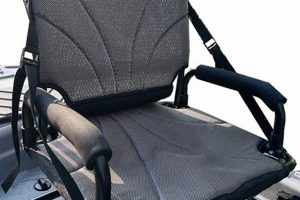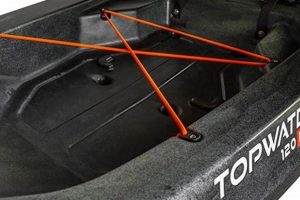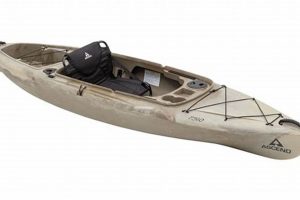Entering the world of angling from a kayak offers a unique blend of mobility and intimacy with nature. It allows access to shallow waters and secluded fishing spots often unreachable by larger boats, providing an immersive experience. Imagine silently gliding across a still lake at dawn, casting a line into the mist-shrouded water. This exemplifies the core essence of the activity, offering a peaceful yet exciting pursuit.
This approach to fishing provides several advantages. Its low environmental impact, affordability compared to motorized boats, and the excellent exercise it provides contribute to its growing popularity. Historically, kayaks have been used for fishing for centuries by various cultures. From indigenous communities utilizing them for sustenance to modern anglers seeking recreation, the practice continues to evolve with advancements in kayak design and fishing technology.
This exploration will delve into essential aspects of preparing for this activity, covering topics such as selecting the right kayak and gear, mastering fundamental paddling and fishing techniques, understanding safety precautions, and identifying suitable fishing locations.
Tips for Beginning Kayak Anglers
Preparation is key to a successful and enjoyable fishing experience from a kayak. The following tips provide guidance for novice anglers.
Tip 1: Select the Right Kayak: Kayak choice depends on individual needs and fishing environments. Sit-on-top kayaks offer stability and ease of re-entry after a water landing, while sit-inside kayaks provide better protection from the elements. Consider factors such as storage capacity, maneuverability, and comfort.
Tip 2: Essential Gear: A properly outfitted kayak enhances safety and efficiency. Essential gear includes a personal flotation device (PFD), a paddle leash, a dry bag for valuables, and appropriate fishing tackle. Rod holders and anchor systems are also recommended.
Tip 3: Practice Paddling Techniques: Mastering basic paddling strokes before venturing out ensures efficient navigation and conserves energy. Practice in calm water to develop proper technique and build confidence.
Tip 4: Learn Basic Fishing Techniques: Understanding fundamental fishing techniques relevant to the target species is crucial. Research appropriate bait, lures, and rigging methods for the intended fishing environment.
Tip 5: Prioritize Safety: Safety should always be paramount. Check weather forecasts before embarking, inform someone of the planned fishing location and estimated return time, and carry a whistle or signaling device.
Tip 6: Respect the Environment: Practice Leave No Trace principles. Pack out all trash, avoid disturbing wildlife, and respect other anglers and boaters.
Tip 7: Start Small and Gradually Increase Complexity: Begin with shorter trips in familiar waters and gradually expand the scope of excursions as skills and confidence develop. Don’t attempt challenging environments or long-distance trips before acquiring sufficient experience.
By adhering to these guidelines, individuals can enjoy a safe and rewarding introduction to this exciting sport. Adequate preparation and a focus on safety are essential for maximizing enjoyment and minimizing risks.
With these foundational elements established, anglers can embark on their kayak fishing journey equipped with the knowledge and skills necessary for success.
1. Kayak Selection
Appropriate kayak selection is fundamental to a positive initial experience in kayak fishing. The vessel serves as the angler’s primary platform, impacting stability, maneuverability, and overall comfort. Choosing a kayak ill-suited to the intended fishing environment or the angler’s skill level can lead to frustration, diminished effectiveness, and potentially compromise safety. For example, a short, recreational kayak designed for calm lakes would be unsuitable for navigating ocean currents or choppy bays. Conversely, a longer, more stable fishing kayak might feel cumbersome and inefficient in small ponds or narrow creeks. The relationship between kayak selection and successful initiation into the sport is therefore crucial.
Several factors influence optimal kayak selection. Hull design plays a significant role in stability and tracking. Wider, flatter hulls offer greater initial stability, beneficial for beginners, while longer, narrower hulls provide enhanced speed and efficiency for traversing larger bodies of water. Sit-on-top kayaks are generally preferred for fishing due to their self-bailing capabilities and ease of entry and exit, particularly advantageous for novice anglers. Sit-inside kayaks, while offering better protection from the elements and a drier ride, can be more challenging to recover from a capsize. Weight capacity should also be considered, factoring in the angler’s weight, gear, and potential catch. Finally, available storage space for tackle and equipment is an essential practical consideration. An angler targeting large game fish, for example, requires significantly more storage than someone fishing for panfish.
Careful consideration of these factors ensures the chosen kayak aligns with the angler’s needs and the intended fishing environment. Selecting a suitable kayak contributes significantly to a positive and productive first experience, fostering confidence and encouraging continued participation in the sport. Neglecting the importance of appropriate kayak selection can lead to a discouraging initial outing, potentially deterring further exploration of this rewarding activity. Understanding the direct link between kayak selection and successful entry into kayak fishing empowers individuals to make informed decisions, ultimately maximizing their enjoyment and chances of success on the water.
2. Essential Gear
Appropriate gear plays a crucial role in safe and successful kayak fishing excursions, particularly for beginners. The correct equipment enhances angler safety, improves fishing effectiveness, and contributes to a more comfortable and enjoyable experience. Neglecting essential gear can lead to preventable accidents, diminished fishing success, and overall frustration. The relationship between essential gear and a positive introduction to kayak fishing is therefore significant. For instance, lacking a personal flotation device (PFD) exposes the angler to significant risk in the event of a capsize, while inadequate fishing tackle can lead to lost opportunities and wasted time. Conversely, possessing the right gear fosters confidence, promotes safety, and increases the likelihood of a successful fishing trip.
Several categories of gear are considered essential for novice kayak anglers. Safety equipment, including a properly fitted PFD and a whistle, is paramount. Navigation tools, such as a compass and a GPS device, aid in orientation and route planning. Appropriate fishing tackle, including rods, reels, lines, lures, and bait, should be selected based on the target species and fishing environment. Storage solutions, such as dry bags and tackle boxes, protect valuables and keep equipment organized. Comfort-enhancing items, such as a padded seat and sun protection, contribute to a more enjoyable experience, especially during longer trips. For example, an angler targeting bass in a freshwater lake requires different tackle than someone fishing for saltwater species in the ocean. Similarly, a kayak angler fishing in cold weather needs appropriate clothing for warmth, whereas someone fishing in hot conditions requires sun protection and hydration solutions.
Understanding the connection between essential gear and successful kayak fishing enables individuals to make informed decisions regarding equipment selection. This preparation enhances safety, improves fishing effectiveness, and contributes to a more positive overall experience. A well-equipped angler is better prepared to handle unexpected situations, maximize fishing opportunities, and enjoy the sport to its fullest. Failure to recognize the importance of essential gear can lead to a negative initial experience, potentially discouraging continued participation in kayak fishing.
3. Safety Procedures
Safety procedures are inextricably linked to a successful introduction to kayak fishing. Adhering to established safety protocols significantly mitigates risks inherent in the activity, fostering a positive and enjoyable experience. Neglecting these procedures can lead to accidents, injuries, and potentially life-threatening situations. The relationship between safety procedures and a positive initiation into kayak fishing is therefore paramount. For instance, failing to wear a personal flotation device (PFD) dramatically increases the risk of drowning in the event of a capsize, while ignoring weather warnings can expose anglers to dangerous conditions on the water. Conversely, prioritizing safety fosters confidence, reduces anxiety, and allows individuals to focus on the enjoyment of the sport.
Several key safety procedures are crucial for novice kayak anglers. Always wearing a PFD is non-negotiable. Checking weather forecasts prior to embarking on any fishing trip allows anglers to avoid hazardous conditions. Informing someone of the planned fishing location and estimated return time provides a crucial safety net in case of emergencies. Carrying a communication device, such as a VHF radio or a mobile phone in a waterproof case, enables communication in case of distress. Understanding basic paddling techniques and self-rescue procedures equips anglers to handle unexpected situations. Carrying a first-aid kit allows for immediate treatment of minor injuries. For example, an angler venturing into coastal waters should be aware of tides and currents, while someone fishing in a remote location should carry extra food and water. Similarly, understanding how to re-enter a kayak after a capsize is a critical skill for all kayak anglers.
Prioritizing safety procedures contributes significantly to a positive and safe initial experience in kayak fishing. A focus on safety builds confidence, reduces the likelihood of accidents, and promotes responsible enjoyment of the sport. Failing to recognize the importance of safety procedures can lead to negative consequences, potentially discouraging future participation. Integrating safety practices into the initial learning phase establishes a foundation for responsible and enjoyable kayak fishing throughout an angler’s development in the sport. This understanding underscores the critical connection between safety procedures and a successful introduction to kayak fishing.
4. Fishing Techniques
Effective fishing techniques are integral to a successful and rewarding introduction to kayak fishing. A clear understanding of fundamental techniques relevant to the target species and fishing environment significantly enhances the likelihood of catching fish, fostering a sense of accomplishment and encouraging continued participation. Conversely, employing inappropriate techniques or lacking fundamental skills can lead to frustration, wasted time, and a potentially negative initial experience. The relationship between fishing techniques and a positive introduction to kayak fishing is therefore crucial. For instance, an angler unfamiliar with proper casting techniques from a seated position in a kayak may experience difficulty reaching desired fishing spots or risk tangling lines. Similarly, using incorrect bait or lures for the target species diminishes the chances of success. Conversely, employing appropriate techniques, such as understanding how to present lures effectively or how to properly set a hook, increases the likelihood of hooking and landing fish.
Several key fishing techniques are particularly relevant for novice kayak anglers. Mastering basic casting techniques from a seated position is essential for accurate lure placement and avoiding line tangles. Understanding how to control the kayak’s position using paddle strokes allows anglers to maintain optimal fishing locations and presentations. Knowledge of different retrieval methods, such as slow rolling, jigging, or twitching, enables anglers to entice strikes from various fish species. Proper hook-setting techniques, tailored to the target species and fishing environment, maximize the chances of landing hooked fish. Employing appropriate fish handling techniques minimizes stress on the fish and promotes conservation. For example, an angler targeting trout in a clear stream might employ delicate presentation techniques and light tackle, while someone fishing for catfish in murky water might use heavier gear and bottom fishing techniques. Similarly, catch-and-release practices require specific handling techniques to minimize harm to the fish.
Developing a foundational understanding of essential fishing techniques empowers individuals to approach kayak fishing with confidence and increases the likelihood of a positive initial experience. This understanding contributes to a more rewarding and productive outing, promoting continued participation in the sport. Failure to grasp these fundamental techniques can lead to frustration and a negative perception of kayak fishing. The integration of effective fishing techniques within the initial learning phase establishes a solid base for skill development and long-term enjoyment of kayak fishing. This understanding reinforces the critical connection between fishing techniques and successful entry into the sport.
5. Location Scouting
Effective location scouting is a critical element for successful introductory experiences in kayak fishing. Appropriate location selection directly influences the likelihood of encountering fish, the ease of access and navigation, and the overall safety and enjoyment of the outing. Neglecting this crucial preparatory step can lead to unproductive fishing trips, navigational challenges, and potential safety hazards. The relationship between location scouting and a positive initiation into kayak fishing is therefore significant. For instance, attempting to fish in areas with heavy boat traffic or strong currents can pose significant risks for novice kayak anglers, while choosing locations with limited fish populations can result in a discouraging and unproductive experience. Conversely, selecting calm, sheltered areas with known fish populations enhances the likelihood of success and fosters a positive initial experience.
Several factors contribute to effective location scouting for beginners. Researching local fishing reports and consulting with experienced anglers provides valuable insights into productive fishing areas and current fishing conditions. Utilizing online mapping tools and nautical charts helps identify suitable launch points, potential hazards, and areas with appropriate water depths and bottom structure. Considering factors such as wind direction and speed, tides and currents, and water clarity helps determine optimal fishing locations and times. Prioritizing locations with easy access and calm water conditions enhances safety and reduces the complexity of the initial experience. For example, a beginner targeting panfish might choose a small, sheltered pond with easy access and clear visibility, while someone seeking larger game fish might research areas with known structure, such as reefs or drop-offs, in larger bodies of water. Similarly, understanding local regulations and obtaining necessary permits ensures compliance and responsible fishing practices.
Careful location scouting contributes significantly to a positive and productive initial experience in kayak fishing. A well-chosen location enhances the likelihood of catching fish, simplifies navigation and access, and promotes a safe and enjoyable outing. This preparation fosters confidence, encourages continued participation, and establishes a foundation for successful future fishing trips. Failure to prioritize location scouting can lead to frustration, diminished success, and potentially negative or hazardous situations. The integration of effective location scouting into the initial learning phase underscores the critical connection between location selection and a successful introduction to kayak fishing.
Frequently Asked Questions
Addressing common inquiries provides clarity and fosters informed decision-making for individuals considering this activity.
Question 1: What type of kayak is best suited for beginners?
Sit-on-top kayaks are generally recommended due to their inherent stability, self-bailing design, and ease of re-entry after a water landing. Wider, shorter models offer enhanced stability for novice paddlers.
Question 2: What essential safety equipment is required?
A properly fitted personal flotation device (PFD) is paramount. A whistle, paddle leash, and communication device are also essential for safety.
Question 3: What basic fishing gear is needed to start?
A medium-action spinning rod and reel combo paired with appropriate fishing line, hooks, and lures suitable for the target species is recommended for initial outings.
Question 4: Where are suitable locations for novice anglers?
Calm, sheltered waters such as small lakes, ponds, or slow-moving rivers offer ideal environments for beginners. Researching local fishing regulations and access points is essential.
Question 5: What are essential paddling techniques for kayak fishing?
Mastering basic forward and reverse strokes, sweep strokes for turning, and draw strokes for maneuvering alongside structures are essential for efficient and controlled kayak movement.
Question 6: How can one improve casting accuracy from a kayak?
Practicing casting from a seated position in a stable environment develops muscle memory and improves accuracy. Utilizing underhand or sidearm casting techniques minimizes the risk of tangling lines overhead.
Addressing these common inquiries provides a foundational understanding of key aspects for prospective kayak anglers. Thorough preparation contributes significantly to a safe, enjoyable, and successful experience.
Further exploration of specific techniques and advanced topics can enhance proficiency and expand fishing opportunities.
Getting Started Kayak Fishing
Successfully entering the realm of kayak fishing hinges upon a multifaceted approach. Appropriate kayak selection, acquisition of essential gear, adherence to safety procedures, mastery of fundamental fishing techniques, and strategic location scouting contribute significantly to positive initial experiences. These interconnected elements form a foundation for safe, enjoyable, and productive outings. Neglecting any of these aspects can compromise safety, diminish fishing success, and potentially discourage continued participation. The integration of these key principles provides a pathway for novice anglers to develop confidence, proficiency, and a deep appreciation for this unique and rewarding sport.
The allure of kayak fishing extends beyond the pursuit of fish. It offers an opportunity to connect with nature, explore hidden waterways, and experience the tranquility of the outdoors. Embracing a mindset of continuous learning, refining techniques, and prioritizing safety ensures long-term enjoyment and fosters a responsible approach to this increasingly popular activity. The journey of kayak fishing begins with careful preparation and a commitment to responsible angling practices. This foundation empowers individuals to experience the full potential of this rewarding pursuit and contributes to the preservation of aquatic environments for future generations.






